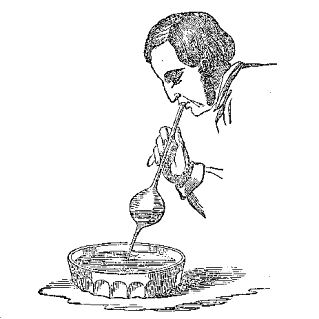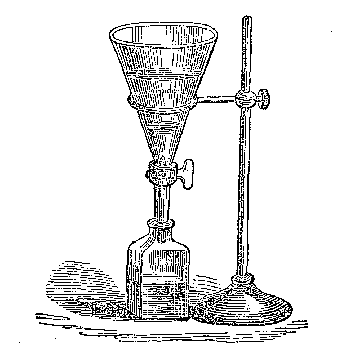
G.W. Septimus Piesse:
The Art of Perfumery
(1857)
excerpt: section 2
"Were not summer's distillations left
A liquid prisoner, pent in walls of glass,
Beauty's effect with beauty were bereft,
Nor it, nor no remembrance what it was;
But flowers distilled, though they with winter meet,
Leese but their show, their substance still lives sweet."
Shakspeare.
The extensive flower farms in the neighborhood of Nice, Grasse, Montpellier, and Cannes, in France, at Adrianople (Turkey in Asia), at Broussa and Uslak (Turkey in Asia), and at Mitcham, in England, in a measure indicate the commercial importance of that branch of chemistry called perfumery.
British India and Europe consume annually, at the very lowest estimate, 150,000 gallons of perfumed spirits, under various titles, such as eau de Cologne, essence of lavender, esprit de rose, &c. The art of perfumery does not, however, confine itself to the production of scents for the handkerchief and bath, but extends to imparting odor to inodorous bodies, such as soap, oil, starch, and grease, which are consumed at the toilette of fashion. Some idea of the commercial importance of this art may be formed, when we state that one of the large perfumers of Grasse and Paris employs annually 80,000 lbs. of orange flowers, 60,000 lbs. of cassia flowers, 54,000 lbs. of rose-leaves, 32,000 lbs. of jasmine blossoms, 32,000 lbs. of violets, 20,000 lbs. of tubereuse, 16,000 lbs. of lilac, besides rosemary, mint, lemon, citron, thyme, and other odorous plants in large proportion. In fact, the quantity of odoriferous substances used in this way is far beyond the conception of those even used to abstract statistics.
To the chemical philosopher, the study of perfumery opens a book as yet unread; for the practical perfumer, on his laboratory shelves, exhibits many rare essential oils, such as essential oil of the flower of the Acacia farnesiana, essential oil of violets, tubereuse, jasmine, and others, the compositions of which have yet to be determined.
The exquisite pleasure derived from smelling fragrant flowers would almost instinctively induce man to attempt to separate the odoriferous principle from them, so as to have the perfume when the season denies the flowers. Thus we find the alchemists of old, torturing the plants in every way their invention could devise for this end; and it is on their experiments that the whole art of perfumery has been reared. Without recapitulating those facts which may be found diffused through nearly all the old authors on medical botany, chemistry, pharmacy, and works of this character, from the time of Paracelsus to Celnart, we may state at once the mode of operation adopted by the practical perfumer of the present day for preparing the various extracts or essences, waters, oils, pomades, &c., used in his calling.
The processes are divided into four distinct operations; viz.—
1. Expression; 2. Distillation; 3. Maceration; 4. Absorption.
1. Expression is only adopted where the plant is very prolific in its volatile or essential oil,—i.e. its odor; such, for instance, as is found in the pellicle or outer peel of the orange, lemon, and citron, and a few others. In these cases, the parts of the plant containing the odoriferous principle are put sometimes in a cloth bag, and at others by themselves into a press, and by mere mechanical force it is squeezed out. The press is an iron vessel of immense strength, varying in size from six inches in diameter, and twelve deep, and upwards, to contain one hundred weight or more; it has a small aperture at the bottom to allow the expressed material to run for collection; in the interior is placed a perforated false bottom, and on this the substance to be squeezed is placed, covered with an iron plate fitting the interior; this is connected with a powerful screw, which, being turned, forces the substance so closely together, that the little vessels containing the essential oils are burst, and it thus escapes. The common tincture press is indeed a model of such an instrument. The oils which are thus collected are contaminated with watery extracts, which exudes at the same time, and from which it has to be separated; this it does by itself in a measure, by standing in a quiet place, and it is then poured off and strained.

Pipette to draw off small portions of otto from water.
2. Distillation.—The plant, or part of it, which contains the odoriferous principle, is placed in an iron, copper, or glass pan, varying in size from that capable of holding from one to twenty gallons, and covered with water; to the pan a dome-shaped lid is fitted, terminating with a pipe, which is twisted corkscrew fashion, and fixed in a bucket, with the end peeping out like a tap in a barrel. The water in the still—for such is the name of the apparatus—is made to boil; and having no other exit, the steam must pass through the coiled pipe; which, being surrounded with cold water in the bucket, condenses the vapor before it can arrive at the tap. With the steam, the volatile oils—i.e. perfume—rises, and is liquefied at the same time. The liquids which thus run over, on standing for a time, separate into two portions, and are finally divided with a funnel having a stopcock in the narrow part of it. By this process, the majority of the volatile or essential oils are procured. In some few instances alcohol—i.e. rectified spirit of wine—is placed upon the odorous materials in lieu of water, which, on being distilled, comes away with the perfuming substance dissolved in it. But this process is now nearly obsolete, as it is found more beneficial to draw the oil or essence first with water, and afterwards to dissolve it in the spirit. The low temperature at which spirit boils, compared with water, causes a great loss of essential oil, the heat not being sufficient to disengage it from the plant, especially where seeds such as cloves or caraway are employed. It so happens, however, that the finest odors, the recherché as the Parisians say, cannot be procured by this method; then recourse is had to the next process.

Tap funnel for separating ottos from water and spirits from oil.
3. Maceration.—Of all the processes for procuring the perfumes of flowers, this is the most important to the perfumer, and is the least understood in England; as this operation yields not only the most exquisite essences indirectly, but also nearly all those fine pomades known here as "French pomatums," so much admired for the strength of fragrance, together with "French oils" equally perfumed. The operation is conducted thus:—For what is called pomade, a certain quantity of purified mutton or deer suet is put into a clean metal or porcelain pan, this being melted by a steam heat; the kind of flowers required for the odor wanted are carefully picked and put into the liquid fat, and allowed to remain from twelve to forty-eight hours; the fat has a particular affinity or attraction for the oil of flowers, and thus, as it were, draws it out of them, and becomes itself, by their aid, highly perfumed; the fat is strained from the spent flowers, and fresh are added four or five times over, till the pomade is of the required strength; these various strengths of pomatums are noted by the French makers as Nos. 6, 12, 18, and 24, the higher numerals indicating the amount of fragrance in them. For perfumed oils the same operation is followed; but, in lieu of suet, fine olive oil or oil of ben, derived from the ben nuts of the Levant, is used, and the same results are obtained. These oils are called "Huile Antique" of such and such a flower.
When neither of the foregoing processes gives satisfactory results, the method of procedure adopted is by,—
4. Absorption, or Enfleurage.—The odors of some flowers are so delicate and volatile, that the heat required in the previously named processes would greatly modify, if not entirely spoil them; this process is, therefore, conducted cold, thus:—Square frames, about three inches deep, with a glass bottom, say two feet wide and three feet long, are procured; over the glass a layer of fat is spread, about half an inch thick, with a kind of plaster knife or spatula; into this the flower buds are stuck, cup downwards, and ranged completely over it, and there left from twelve to seventy-two hours.
Some houses, such as that of Messrs. Pilar and Sons; Pascal Brothers; H. Herman, and a few others, have 3000 such frames at work during the season; as they are filled, they are piled one over the other, the flowers are changed so long as the plants continue to bloom, which now and then exceeds two or three months.
For oils of the same plants, coarse linen cloths are imbued with the finest olive oil or oil of ben, and stretched upon a frame made of iron; on these the flowers are laid and suffered to remain a few days. This operation is repeated several times, after which the cloths are subjected to great pressure, to remove the now perfumed oil.
As we cannot give any general rule for working, without misleading the reader, we prefer explaining the process required for each when we come to speak of the individual flower or plant.
This eBook is for the use of anyone anywhere at no cost and with almost no restrictions whatsoever. You may copy it, give it away or re-use it under the terms of the Project Gutenberg License included with this eBook or online at www.gutenberg.net
http://www.gutenberg.org/licenseRelease Date [EBook #16378]: July 28, 2005
Produced by The Online Distributed Proofreading Team at http://www.pgdp.net